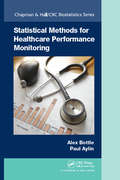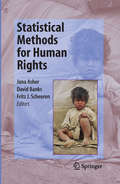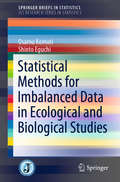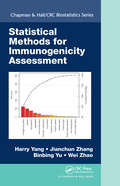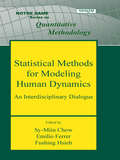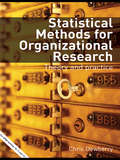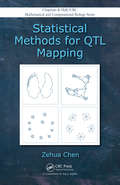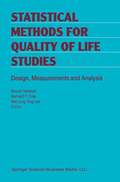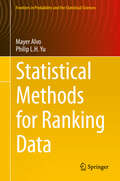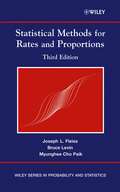- Table View
- List View
Statistical Methods for Handling Incomplete Data
by Jae Kwang KimDue to recent theoretical findings and advances in statistical computing, there has been a rapid development of techniques and applications in the area of missing data analysis. Statistical Methods for Handling Incomplete Data covers the most up-to-date statistical theories and computational methods for analyzing incomplete data.Suitable for gradua
Statistical Methods for Handling Incomplete Data
by Jae Kwang Kim Jun ShaoDue to recent theoretical findings and advances in statistical computing, there has been a rapid development of techniques and applications in the area of missing data analysis. Statistical Methods for Handling Incomplete Data covers the most up-to-date statistical theories and computational methods for analyzing incomplete data. Features Uses the mean score equation as a building block for developing the theory for missing data analysis Provides comprehensive coverage of computational techniques for missing data analysis Presents a rigorous treatment of imputation techniques, including multiple imputation fractional imputation Explores the most recent advances of the propensity score method and estimation techniques for nonignorable missing data Describes a survey sampling application Updated with a new chapter on Data Integration Now includes a chapter on Advanced Topics, including kernel ridge regression imputation and neural network model imputation The book is primarily aimed at researchers and graduate students from statistics, and could be used as a reference by applied researchers with a good quantitative background. It includes many real data examples and simulated examples to help readers understand the methodologies.
Statistical Methods for Handling Incomplete Data
by Jae Kwang Kim Jun ShaoDue to recent theoretical findings and advances in statistical computing, there has been a rapid development of techniques and applications in the area of missing data analysis. Statistical Methods for Handling Incomplete Data covers the most up-to-date statistical theories and computational methods for analyzing incomplete data. Features Uses the mean score equation as a building block for developing the theory for missing data analysis Provides comprehensive coverage of computational techniques for missing data analysis Presents a rigorous treatment of imputation techniques, including multiple imputation fractional imputation Explores the most recent advances of the propensity score method and estimation techniques for nonignorable missing data Describes a survey sampling application Updated with a new chapter on Data Integration Now includes a chapter on Advanced Topics, including kernel ridge regression imputation and neural network model imputation The book is primarily aimed at researchers and graduate students from statistics, and could be used as a reference by applied researchers with a good quantitative background. It includes many real data examples and simulated examples to help readers understand the methodologies.
Statistical Methods for Healthcare Performance Monitoring (Chapman & Hall/CRC Biostatistics Series)
by Alex Bottle Paul AylinHealthcare is important to everyone, yet large variations in its quality have been well documented both between and within many countries. With demand and expenditure rising, it’s more crucial than ever to know how well the healthcare system and all its components – from staff member to regional network – are performing. This requires data, which inevitably differ in form and quality. It also requires statistical methods, the output of which needs to be presented so that it can be understood by whoever needs it to make decisions. Statistical Methods for Healthcare Performance Monitoring covers measuring quality, types of data, risk adjustment, defining good and bad performance, statistical monitoring, presenting the results to different audiences and evaluating the monitoring system itself. Using examples from around the world, it brings all the issues and perspectives together in a largely non-technical way for clinicians, managers and methodologists. Statistical Methods for Healthcare Performance Monitoring is aimed at statisticians and researchers who need to know how to measure and compare performance, health service regulators, health service managers with responsibilities for monitoring performance, and quality improvement scientists, including those involved in clinical audits.
Statistical Methods for Healthcare Performance Monitoring (Chapman & Hall/CRC Biostatistics Series)
by Alex Bottle Paul AylinHealthcare is important to everyone, yet large variations in its quality have been well documented both between and within many countries. With demand and expenditure rising, it’s more crucial than ever to know how well the healthcare system and all its components – from staff member to regional network – are performing. This requires data, which inevitably differ in form and quality. It also requires statistical methods, the output of which needs to be presented so that it can be understood by whoever needs it to make decisions. Statistical Methods for Healthcare Performance Monitoring covers measuring quality, types of data, risk adjustment, defining good and bad performance, statistical monitoring, presenting the results to different audiences and evaluating the monitoring system itself. Using examples from around the world, it brings all the issues and perspectives together in a largely non-technical way for clinicians, managers and methodologists. Statistical Methods for Healthcare Performance Monitoring is aimed at statisticians and researchers who need to know how to measure and compare performance, health service regulators, health service managers with responsibilities for monitoring performance, and quality improvement scientists, including those involved in clinical audits.
Statistical Methods for Human Rights
by Jana Asher David Banks Fritz J. ScheurenHuman rights issues are shaping the modern world. They define the expectations by which nations are judged and affect the policy of governments, corporations, and foundations. Statistics is central to the modern perspective on human rights. It allows researchers to measure the effect of health care policies, the penetration of educational opportunity, and progress towards gender equality. This book describes the statistics that underlie the social science research in human rights. It includes case studies, methodology, and research papers that discuss the fundamental measurement issues.
Statistical Methods for Imbalanced Data in Ecological and Biological Studies (SpringerBriefs in Statistics)
by Osamu Komori Shinto EguchiThis book presents a fresh, new approach in that it provides a comprehensive recent review of challenging problems caused by imbalanced data in prediction and classification, and also in that it introduces several of the latest statistical methods of dealing with these problems. The book discusses the property of the imbalance of data from two points of view. The first is quantitative imbalance, meaning that the sample size in one population highly outnumbers that in another population. It includes presence-only data as an extreme case, where the presence of a species is confirmed, whereas the information on its absence is uncertain, which is especially common in ecology in predicting habitat distribution. The second is qualitative imbalance, meaning that the data distribution of one population can be well specified whereas that of the other one shows a highly heterogeneous property. A typical case is the existence of outliers commonly observed in gene expression data, and another is heterogeneous characteristics often observed in a case group in case-control studies. The extension of the logistic regression model, maxent, and AdaBoost for imbalanced data is discussed, providing a new framework for improvement of prediction, classification, and performance of variable selection. Weights functions introduced in the methods play an important role in alleviating the imbalance of data. This book also furnishes a new perspective on these problem and shows some applications of the recently developed statistical methods to real data sets.
Statistical Methods for Immunogenicity Assessment
by Harry Yang Jianchun Zhang Binbing Yu Wei ZhaoDevelop Effective Immunogenicity Risk Mitigation StrategiesImmunogenicity assessment is a prerequisite for the successful development of biopharmaceuticals, including safety and efficacy evaluation. Using advanced statistical methods in the study design and analysis stages is therefore essential to immunogenicity risk assessment and mitigation stra
Statistical Methods for Materials Science: The Data Science of Microstructure Characterization
by Jeffrey P. Simmons Charles A. Bouman Marc De Graef Lawrence F. DrummyData analytics has become an integral part of materials science. This book provides the practical tools and fundamentals needed for researchers in materials science to understand how to analyze large datasets using statistical methods, especially inverse methods applied to microstructure characterization. It contains valuable guidance on essential topics such as denoising and data modeling. Additionally, the analysis and applications section addresses compressed sensing methods, stochastic models, extreme estimation, and approaches to pattern detection.
Statistical Methods for Materials Science: The Data Science of Microstructure Characterization
by Jeffrey P. Simmons Lawrence F. Drummy Charles A. Bouman Marc De GraefData analytics has become an integral part of materials science. This book provides the practical tools and fundamentals needed for researchers in materials science to understand how to analyze large datasets using statistical methods, especially inverse methods applied to microstructure characterization. It contains valuable guidance on essential topics such as denoising and data modeling. Additionally, the analysis and applications section addresses compressed sensing methods, stochastic models, extreme estimation, and approaches to pattern detection.
Statistical Methods for Mediation, Confounding and Moderation Analysis Using R and SAS (Chapman & Hall/CRC Biostatistics Series)
by Qingzhao Yu Bin LiThird-variable effect refers to the effect transmitted by third-variables that intervene in the relationship between an exposure and a response variable. Differentiating between the indirect effect of individual factors from multiple third-variables is a constant problem for modern researchers. Statistical Methods for Mediation, Confounding and Moderation Analysis Using R and SAS introduces general definitions of third-variable effects that are adaptable to all different types of response (categorical or continuous), exposure, or third-variables. Using this method, multiple third- variables of different types can be considered simultaneously, and the indirect effect carried by individual third-variables can be separated from the total effect. Readers of all disciplines familiar with introductory statistics will find this a valuable resource for analysis. Key Features: Parametric and nonparametric method in third variable analysis Multivariate and Multiple third-variable effect analysis Multilevel mediation/confounding analysis Third-variable effect analysis with high-dimensional data Moderation/Interaction effect analysis within the third-variable analysis R packages and SAS macros to implement methods proposed in the book
Statistical Methods for Mediation, Confounding and Moderation Analysis Using R and SAS (Chapman & Hall/CRC Biostatistics Series)
by Qingzhao Yu Bin LiThird-variable effect refers to the effect transmitted by third-variables that intervene in the relationship between an exposure and a response variable. Differentiating between the indirect effect of individual factors from multiple third-variables is a constant problem for modern researchers. Statistical Methods for Mediation, Confounding and Moderation Analysis Using R and SAS introduces general definitions of third-variable effects that are adaptable to all different types of response (categorical or continuous), exposure, or third-variables. Using this method, multiple third- variables of different types can be considered simultaneously, and the indirect effect carried by individual third-variables can be separated from the total effect. Readers of all disciplines familiar with introductory statistics will find this a valuable resource for analysis. Key Features: Parametric and nonparametric method in third variable analysis Multivariate and Multiple third-variable effect analysis Multilevel mediation/confounding analysis Third-variable effect analysis with high-dimensional data Moderation/Interaction effect analysis within the third-variable analysis R packages and SAS macros to implement methods proposed in the book
Statistical Methods for Meta-Analysis
by Larry V. Hedges Ingram OlkinThe main purpose of this book is to address the statistical issues for integrating independent studies. There exist a number of papers and books that discuss the mechanics of collecting, coding, and preparing data for a meta-analysis , and we do not deal with these. Because this book concerns methodology, the content necessarily is statistical, and at times mathematical. In order to make the material accessible to a wider audience, we have not provided proofs in the text. Where proofs are given, they are placed as commentary at the end of a chapter. These can be omitted at the discretion of the reader.Throughout the book we describe computational procedures whenever required. Many computations can be completed on a hand calculator, whereas some require the use of a standard statistical package such as SAS, SPSS, or BMD. Readers with experience using a statistical package or who conduct analyses such as multiple regression or analysis of variance should be able to carry out the analyses described with the aid of a statistical package.
Statistical Methods for Modeling Human Dynamics: An Interdisciplinary Dialogue (Notre Dame Series on Quantitative Methodology)
by Sy-Miin Chow Emilio Ferrer Fushing HsiehThis interdisciplinary volume features contributions from researchers in the fields of psychology, neuroscience, statistics, computer science, and physics. State-of-the-art techniques and applications used to analyze data obtained from studies in cognition, emotion, and electrophysiology are reviewed along with techniques for modeling in real time and for examining lifespan cognitive changes, for conceptualizing change using item response, nonparametric and hierarchical models, and control theory-inspired techniques for deriving diagnoses in medical and psychotherapeutic settings. The syntax for running the analyses presented in the book is provided on the Psychology Press site. Most of the programs are written in R while others are for Matlab, SAS, Win-BUGS, and DyFA. Readers will appreciate a review of the latest methodological techniques developed in the last few years. Highlights include an examination of: Statistical and mathematical modeling techniques for the analysis of brain imaging such as EEGs, fMRIs, and other neuroscience data Dynamic modeling techniques for intensive repeated measurement data Panel modeling techniques for fewer time points data State-space modeling techniques for psychological data Techniques used to analyze reaction time data. Each chapter features an introductory overview of the techniques needed to understand the chapter, a summary, and numerous examples. Each self-contained chapter can be read on its own and in any order. Divided into three major sections, the book examines techniques for examining within-person derivations in change patterns, intra-individual change, and inter-individual differences in change and interpersonal dynamics. Intended for advanced students and researchers, this book will appeal to those interested in applying state-of-the-art dynamic modeling techniques to the the study of neurological, developmental, cognitive, and social/personality psychology, as well as neuroscience, computer science, and engineering.
Statistical Methods for Modeling Human Dynamics: An Interdisciplinary Dialogue (Notre Dame Series on Quantitative Methodology)
by Sy-Minn Chow Emilio Ferrer Fushing HsiehThis interdisciplinary volume features contributions from researchers in the fields of psychology, neuroscience, statistics, computer science, and physics. State-of-the-art techniques and applications used to analyze data obtained from studies in cognition, emotion, and electrophysiology are reviewed along with techniques for modeling in real time and for examining lifespan cognitive changes, for conceptualizing change using item response, nonparametric and hierarchical models, and control theory-inspired techniques for deriving diagnoses in medical and psychotherapeutic settings. The syntax for running the analyses presented in the book is provided on the Psychology Press site. Most of the programs are written in R while others are for Matlab, SAS, Win-BUGS, and DyFA. Readers will appreciate a review of the latest methodological techniques developed in the last few years. Highlights include an examination of: Statistical and mathematical modeling techniques for the analysis of brain imaging such as EEGs, fMRIs, and other neuroscience data Dynamic modeling techniques for intensive repeated measurement data Panel modeling techniques for fewer time points data State-space modeling techniques for psychological data Techniques used to analyze reaction time data. Each chapter features an introductory overview of the techniques needed to understand the chapter, a summary, and numerous examples. Each self-contained chapter can be read on its own and in any order. Divided into three major sections, the book examines techniques for examining within-person derivations in change patterns, intra-individual change, and inter-individual differences in change and interpersonal dynamics. Intended for advanced students and researchers, this book will appeal to those interested in applying state-of-the-art dynamic modeling techniques to the the study of neurological, developmental, cognitive, and social/personality psychology, as well as neuroscience, computer science, and engineering.
Statistical Methods for Organizational Research: Theory and Practice
by Chris DewberryThis clearly written textbook clarifies the concepts underpinning descriptive and inferential statistics in organizational research. Acting as much more than a theoretical reference tool, step-by-step it guides readers through the various key stages of successful data analysis.Covering everything from introductory descriptive statistics to advanced inferential techniques such as ANOVA, multiple and logistic regression and factor analysis, this is one of the most comprehensive textbooks available. Using examples directly relevant to organizational research it includes practical advice on such topics as the size of samples required in research studies, using and interpreting SPSS, and writing up results. In helping readers to develop a sound understanding of statistical methods, rather than focusing on complex formulas and computations, this outstanding textbook is as appropriate for those who wish to refresh their knowledge as those new to the subject area.
Statistical Methods for Organizational Research: Theory and Practice
by Chris DewberryThis clearly written textbook clarifies the concepts underpinning descriptive and inferential statistics in organizational research. Acting as much more than a theoretical reference tool, step-by-step it guides readers through the various key stages of successful data analysis.Covering everything from introductory descriptive statistics to advanced inferential techniques such as ANOVA, multiple and logistic regression and factor analysis, this is one of the most comprehensive textbooks available. Using examples directly relevant to organizational research it includes practical advice on such topics as the size of samples required in research studies, using and interpreting SPSS, and writing up results. In helping readers to develop a sound understanding of statistical methods, rather than focusing on complex formulas and computations, this outstanding textbook is as appropriate for those who wish to refresh their knowledge as those new to the subject area.
Statistical Methods for QTL Mapping (Chapman & Hall/CRC Computational Biology Series)
by Zehua ChenWhile numerous advanced statistical approaches have recently been developed for quantitative trait loci (QTL) mapping, the methods are scattered throughout the literature. Statistical Methods for QTL Mapping brings together many recent statistical techniques that address the data complexity of QTL mapping. After introducing basic genetics topics an
Statistical Methods for QTL Mapping (Chapman & Hall/CRC Computational Biology Series)
by Zehua ChenWhile numerous advanced statistical approaches have recently been developed for quantitative trait loci (QTL) mapping, the methods are scattered throughout the literature. Statistical Methods for QTL Mapping brings together many recent statistical techniques that address the data complexity of QTL mapping. After introducing basic genetics topics an
Statistical Methods for Quality Assurance: Basics, Measurement, Control, Capability, and Improvement (Springer Texts in Statistics)
by Stephen B. Vardeman J. Marcus JobeThis undergraduate statistical quality assurance textbook clearly shows with real projects, cases and data sets how statistical quality control tools are used in practice. Among the topics covered is a practical evaluation of measurement effectiveness for both continuous and discrete data. Gauge Reproducibility and Repeatability methodology (including confidence intervals for Repeatability, Reproducibility and the Gauge Capability Ratio) is thoroughly developed. Process capability indices and corresponding confidence intervals are also explained. In addition to process monitoring techniques, experimental design and analysis for process improvement are carefully presented. Factorial and Fractional Factorial arrangements of treatments and Response Surface methods are covered.Integrated throughout the book are rich sets of examples and problems that help readers gain a better understanding of where and how to apply statistical quality control tools. These large and realistic problem sets in combination with the streamlined approach of the text and extensive supporting material facilitate reader understanding.Second Edition ImprovementsExtensive coverage of measurement quality evaluation (in addition to ANOVA Gauge R&R methodologies)New end-of-section exercises and revised-end-of-chapter exercisesTwo full sets of slides, one with audio to assist student preparation outside-of-class and another appropriate for professors’ lecturesSubstantial supporting materialSupporting MaterialSeven R programs that support variables and attributes control chart construction and analyses, Gauge R&R methods, analyses of Fractional Factorial studies, Propagation of Error analyses and Response Surface analysesDocumentation for the R programsExcel data files associated with the end-of-chapter problem sets, most from real engineering settings
Statistical Methods for Quality of Life Studies: Design, Measurements and Analysis
by Mounir Mesbah Bernard F. Cole Mei-Ling Ting Mei-Ling Ting LeeOn October 16 and 17, 2000, we hosted an international workshop entitled "Statistical Design, Measurement, and Analysis of Health Related Quality of Life." The workshop was held in the beautiful city of Arradon, South Brittany, France with the main goal of fostering an interdisciplinary forum for discussion of theoretical and applied statistical issues arising in studies of health-related quality of life (HRQoL). Included were biostatisticians, psychometricians and public health professionals (e.g., physicians, sociologists, psychologists) active in the study ofHRQoL. In assembling this volume, we invited each conference participant to contribute a paper based on his or her presentation and the ensuing and very interesting discussions that took place in Arradon. All papers were peer-reviewed, by anonymous reviewers, and revised before final editing and acceptance. Although this process was quite time consuming, we believe that it greatly improved the volume as a whole, making this book a valuable contribution to the field ofHRQoL research. The volume presents a broad spectrum of papers presented at the Workshop, and thus illustrates the range of current research related to the theory, methods and applications of HRQoL, as well as the interdisciplinary nature ofthis work. Following an introduction written by Sir David Cox, it includes 27 articles organized into the following chapters.
Statistical Methods for Ranking Data (Frontiers in Probability and the Statistical Sciences)
by Mayer Alvo Philip L.H. YuThis book introduces advanced undergraduate, graduate students and practitioners to statistical methods for ranking data. An important aspect of nonparametric statistics is oriented towards the use of ranking data. Rank correlation is defined through the notion of distance functions and the notion of compatibility is introduced to deal with incomplete data. Ranking data are also modeled using a variety of modern tools such as CART, MCMC, EM algorithm and factor analysis.This book deals with statistical methods used for analyzing such data and provides a novel and unifying approach for hypotheses testing. The techniques described in the book are illustrated with examples and the statistical software is provided on the authors’ website.
Statistical Methods for Rates and Proportions (Wiley Series in Probability and Statistics #477)
by Joseph L. Fleiss Bruce Levin Myunghee Cho Paik* Includes a new chapter on logistic regression. * Discusses the design and analysis of random trials. * Explores the latest applications of sample size tables. * Contains a new section on binomial distribution.
Statistical Methods for Rates and Proportions (Wiley Series in Probability and Statistics #477)
by Joseph L. Fleiss Bruce Levin Myunghee Cho Paik* Includes a new chapter on logistic regression. * Discusses the design and analysis of random trials. * Explores the latest applications of sample size tables. * Contains a new section on binomial distribution.
Statistical Methods for Reliability Data (Wiley Series in Probability and Statistics #314)
by William Q. Meeker Luis A. EscobarAmstat News asked three review editors to rate their top five favorite books in the September 2003 issue. Statistical Methods for Reliability Data was among those chosen. Bringing statistical methods for reliability testing in line with the computer age This volume presents state-of-the-art, computer-based statistical methods for reliability data analysis and test planning for industrial products. Statistical Methods for Reliability Data updates and improves established techniques as it demonstrates how to apply the new graphical, numerical, or simulation-based methods to a broad range of models encountered in reliability data analysis. It includes methods for planning reliability studies and analyzing degradation data, simulation methods used to complement large-sample asymptotic theory, general likelihood-based methods of handling arbitrarily censored data and truncated data, and more. In this book, engineers and statisticians in industry and academia will find: A wealth of information and procedures developed to give products a competitive edge Simple examples of data analysis computed with the S-PLUS system-for which a suite of functions and commands is available over the Internet End-of-chapter, real-data exercise sets Hundreds of computer graphics illustrating data, results of analyses, and technical concepts An essential resource for practitioners involved in product reliability and design decisions, Statistical Methods for Reliability Data is also an excellent textbook for on-the-job training courses, and for university courses on applied reliability data analysis at the graduate level. An Instructor's Manual presenting detailed solutions to all the problems in the book is available upon requestfrom the Wiley editorial department.


